swagger扩展注解
@KPApiJsonlParam
- 作用:对入参是json的(@RequestBody)生成接口参数说明
用法及效果
示例一
@ApiOperation(value = "设置用户", notes = "权限 auth:role:add:user") @KPApiJsonlParam({ @ApiModelProperty(name = "roleId", value = "角色Id", required = true), @ApiModelProperty(name = "userIds", value = "用户id集合", required = true, dataType = "list") }) @PostMapping(value = "/add/user") @ResponseBody public KPResult roleAddUser(@RequestBody RoleUserPO roleUserPO) { userRoleService.userRoleService(parameter); return KPResult.success(); }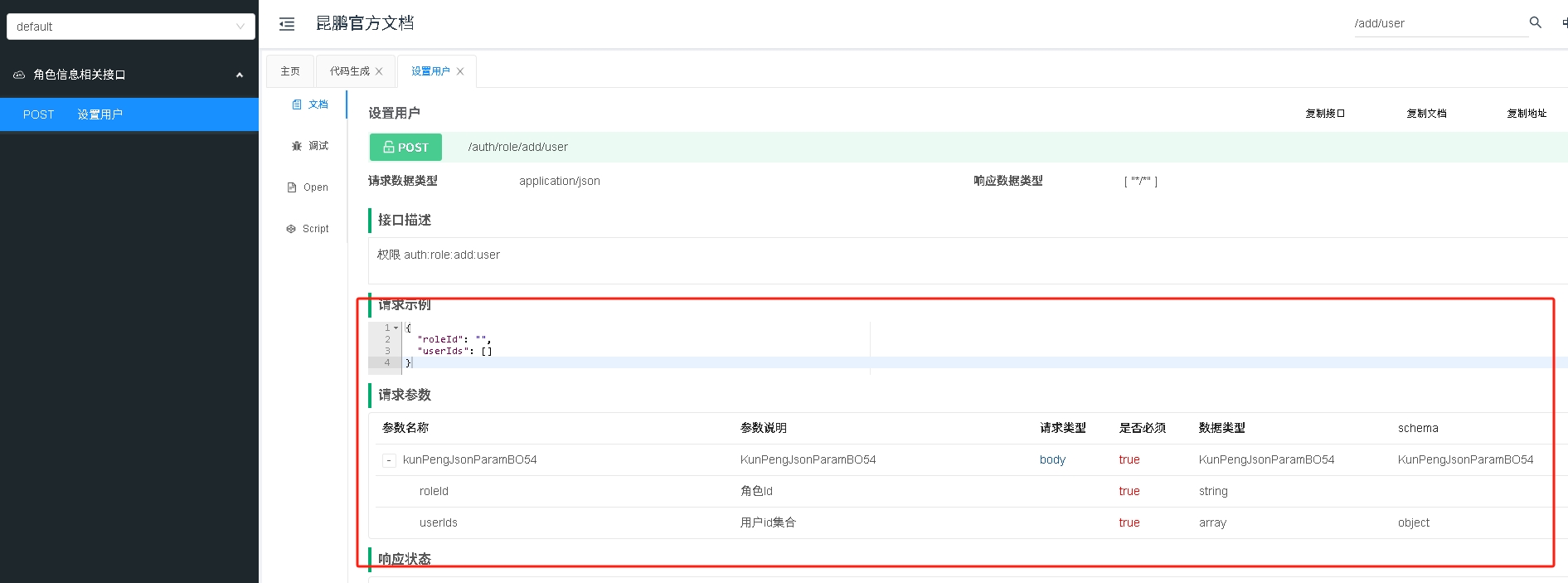
示例二
@ApiOperation(value = "批量注销", notes = "权限 auth:user:batch:cancel") @PostMapping(value = "/batch/cancel") @KPApiJsonlParam({ @ApiModelProperty(name = "ids", value = "用户Id", required = true, dataType = "list") }) @ResponseBody public KPResult doCancel(@RequestBody List<String> ids) { return userService.doCancel(ids); }
@KPApiJsonlParamMode
作用:对入参是json的(@RequestBody)生成接口参数说明,从现有的实体类上抽取指定的字段 或 屏蔽指定的字段
参数说明:
separator:分隔符 默认是英文逗号
component:目标实体类
ignores:忽略的字段
includes:包含的字段
用法及效果
示例一
//展示UserListParamPO实体里面除去pageNum,pageSize的所有字段 @ApiOperation(value = "查询用户信息-不带分页", notes = "权限 auth:user:page:list") @PostMapping(value = "/list") @KPApiJsonlParamMode(component = UserListParamPO.class, ignores = "pageNum,pageSize") @ResponseBody public KPResult<List<UserListCustomerPO>> queryList(@RequestBody UserListParamPO userListParamPO) { return KPResult.success(userService.queryList(userListParamPO)); }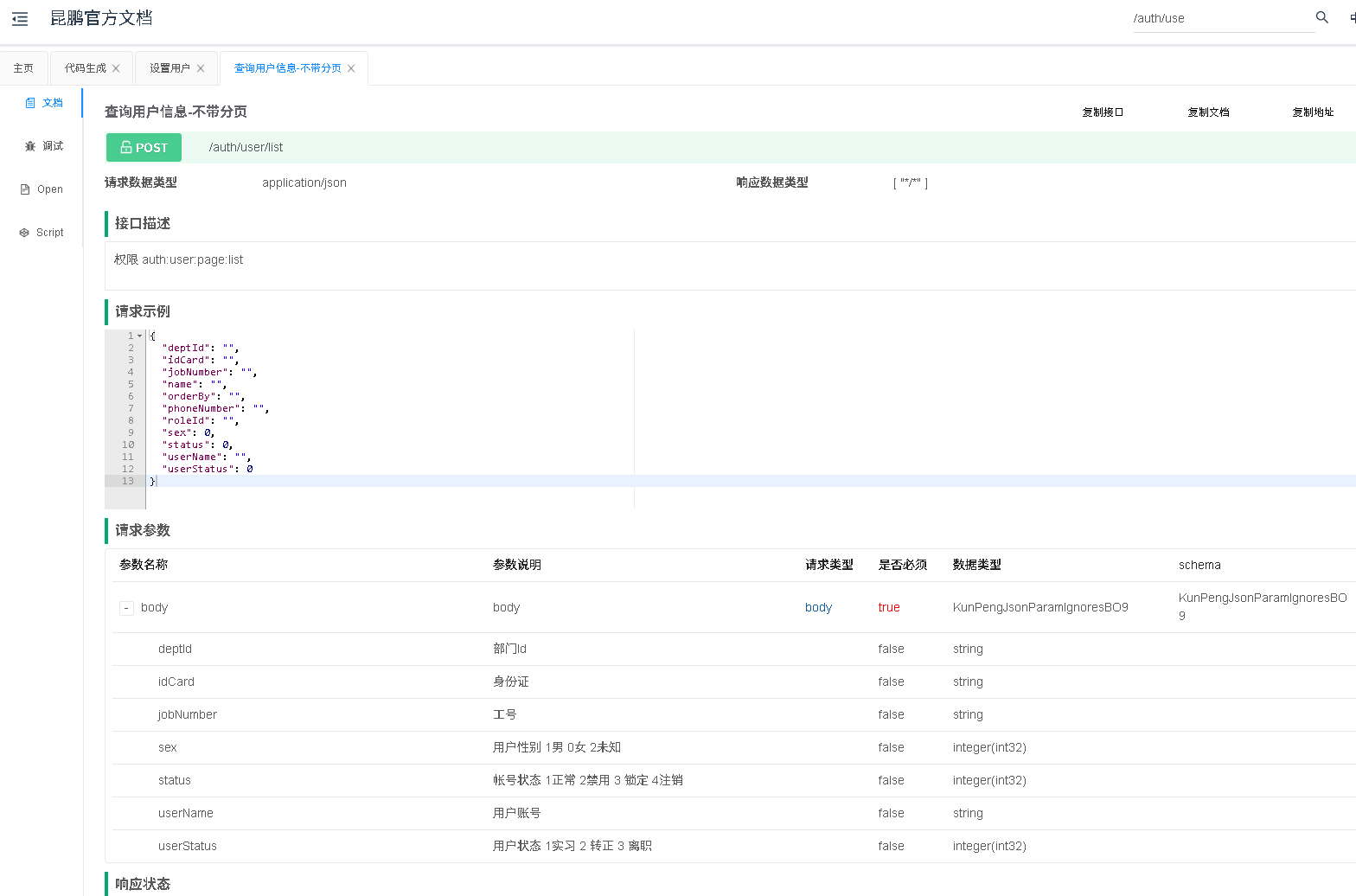
示例二
//展示DeptListParamPO实体里面isTree字段 @ApiOperation(value = "查询部门下拉框") @PostMapping("/dept/select") @KPApiJsonlParamMode(component = DeptListParamPO.class, includes = "isTree") @ResponseBody public KPResult<List<DictionaryChildrenBO>> queryProjectSelect(@RequestBody DeptListParamPO deptListParamPO) { return KPResult.success(KPServiceUtil.getBean(DeptService.class).queryDeptSelect(deptListParamPO)); }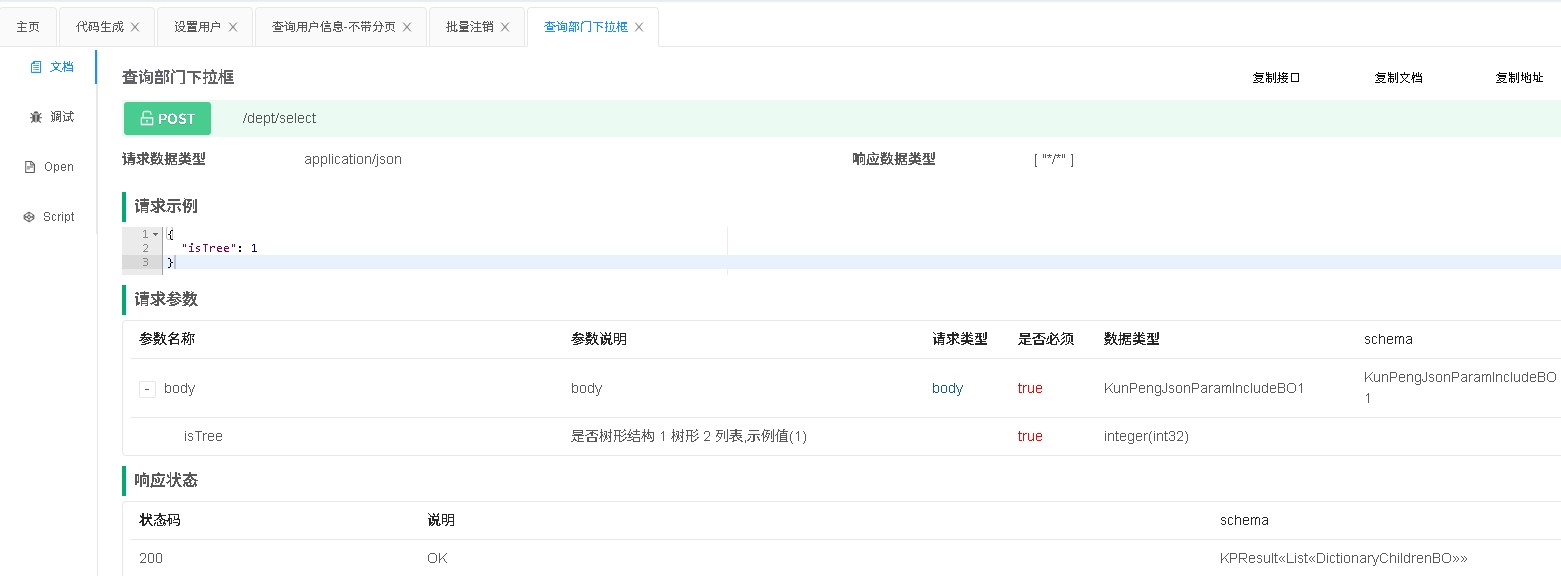
权限注解
@PreAuthorize
作用:spring security 权限注解,用于在接口调用之前对用户权限进行验证。昆鹏框架进行二次发开 用于验证权限
参数说明:
hasPermission:设置访问权限 第一个参数表示接口全路径,第二个参数表示权限标识
补充:权限控制具体操作,请查看 权限配置
用法
#表示调用该接口, 用户必须有auth:user:save 权限 权限控制具体查看 权限配置说明 @PreAuthorize("hasPermission('/auth/user/save','auth:user:save')") @ApiOperation(value = "新增用户信息", notes="权限 auth:user:save") @PostMapping("/save") @KPVerifyNote @KPApiJsonlParamMode(component = UserEditParamPO.class, ignores = "userId") public KPResult<UserPO> save(@RequestBody UserEditParamPO userEditParamPO){ userService.saveUser(userEditParamPO); return KPResult.success(); }
@KPDataPermissions
作用:用于验证数据权限。数据权限控制在鉴权系统进行
参数说明:
userFileName:用户id字段 默认 create_user_id
deptFileName:默认id字段 默认 dept_id
excludeTableName:要排除的表名, 多个表用逗号分隔 (如果我们的接口执行多个查询语句,但有的查询语句不需要再where 自动拼接数据权限)
补充:添加该注解后,查询的sql语句会自动根据当前用户角色设置的数据权限进行过滤(在最终查询语句中 自动拼接where条件 无需程序员添加数据权限过滤条件)、如果用户有多个角色、取最大数据权限进行查询
用法以配置方式
@PreAuthorize("hasPermission('/auth/post/page/list', 'auth:post:page:list')") @ApiOperation(value = "查询岗位信息分页列表", notes = "权限 auth:post:page:list") @PostMapping("/page/list") @KPDataPermissions(excludeTableName="auth_user") @KPVerifyNote public KPResult<PostPO> queryList(@RequestBody PostListParamPO postListParamPO){ return KPResult.list(postService.queryPageList(postListParamPO)); }数据权限设置方式 在角色列表中数据权限配置页面进行配置
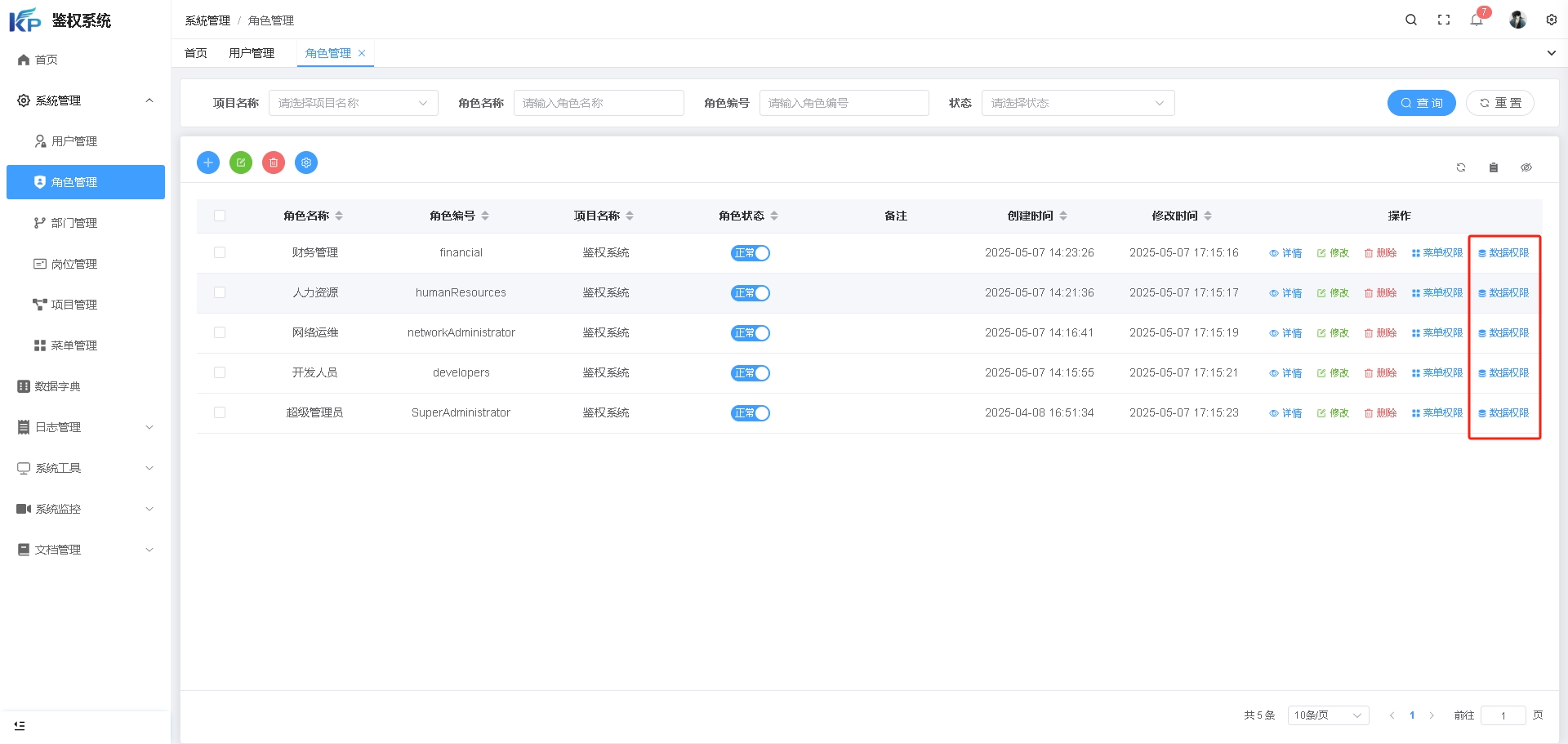
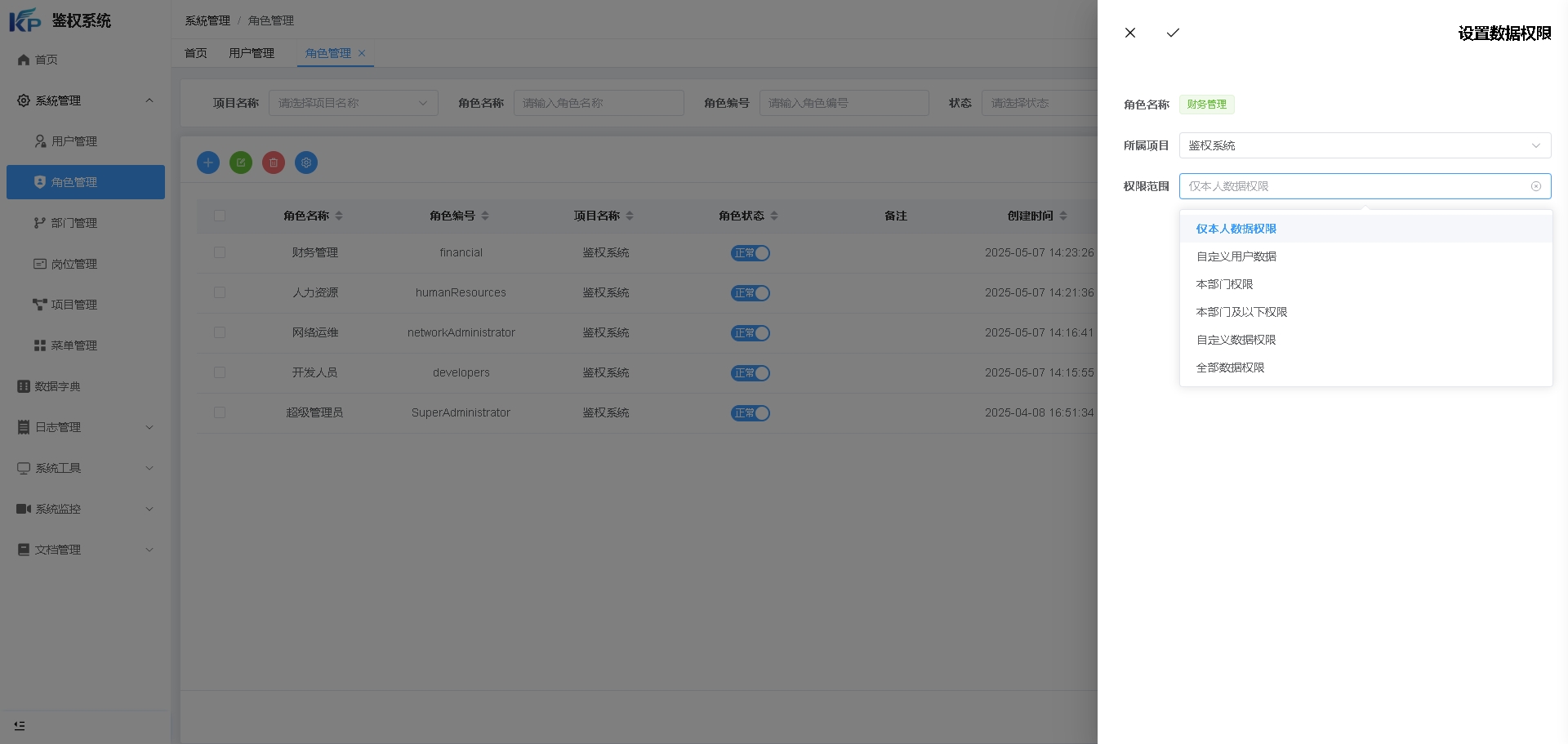
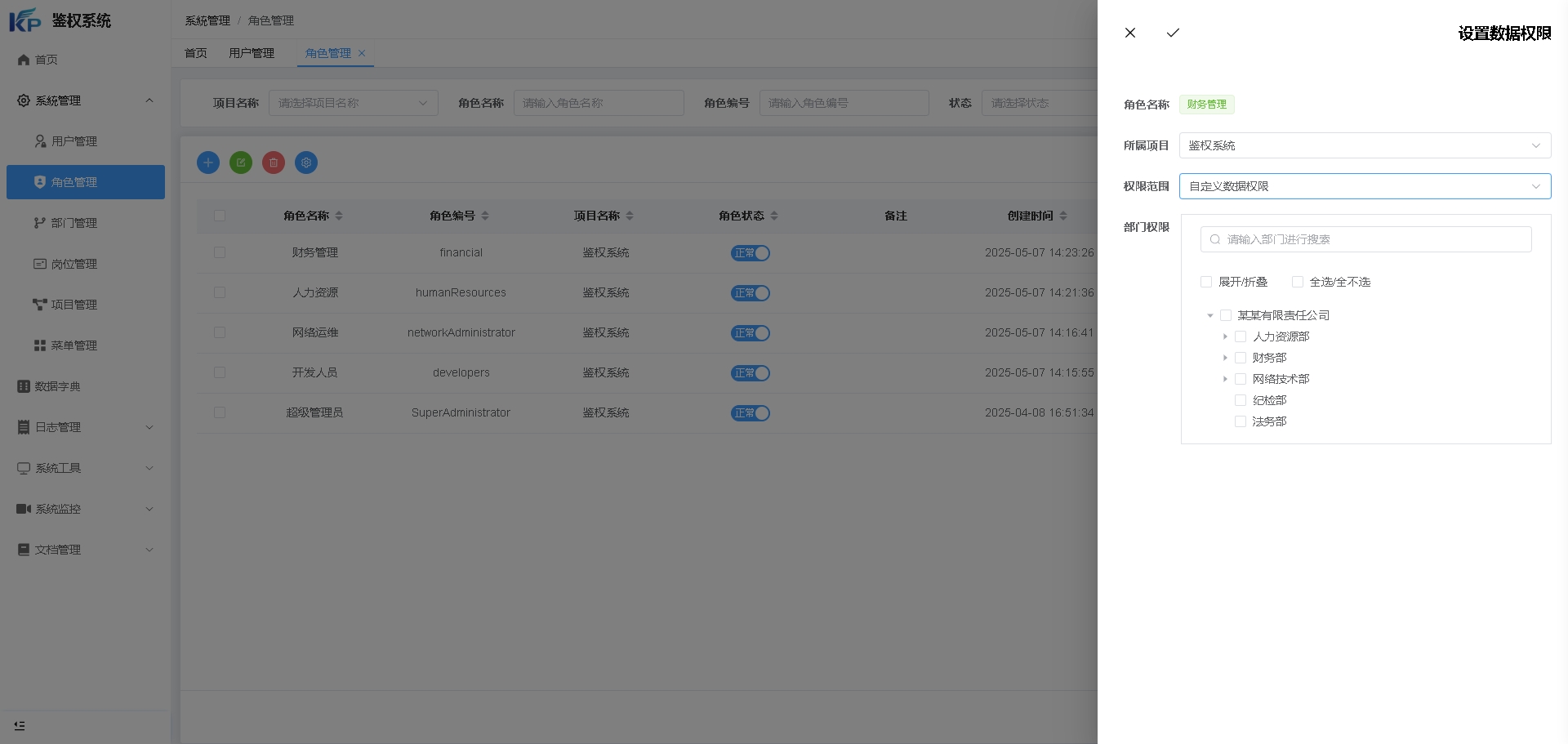
校验器注解
@KPVerifyNote
- 作用:开启注解校验
- 说明:昆鹏框架开发了自己的注解校验器、简化用户对应参数的校验。如果使用注解校验器 需要先在接口上使用@KPVerifyNote 打开注解校验器 如果不加该注解 即使使用了注解校验 也不起作用
- 补充:注解校验器底层实现是 昆鹏工具类中 KPVerifyUtil 校验方法 KPVerifyUtil 提供全量的校验方法 单注解目前只提供以下注解 其他的会在后续新增
用法
@PreAuthorize("hasPermission('/auth/post/save','auth:post:save')") @ApiOperation(value = "新增岗位信息", notes="权限 auth:post:save") @PostMapping("/save") @KPVerifyNote @KPApiJsonlParamMode(component = PostEditParamPO.class, ignores = "postId") public KPResult<PostPO> save(@RequestBody PostEditParamPO postEditParamPO){ postService.savePost(postEditParamPO); return KPResult.success(); }
@KPNotNull
作用:非空校验
说明:加在实体类上用于校验非空 不限数据类型 任何类型都可进行校验
参数说明:
errMeg:校验失败提示语
用法
@Data @Accessors(chain = true) @ApiModel(value = "PostEditParamPO对象", description = "岗位信息编辑入参") public class PostEditParamPO { private static final long serialVersionUID = 1L; @ApiModelProperty(value = "岗位Id", example = "岗位Id", required = true) @TableId(value = "post_id", type = IdType.ASSIGN_UUID) @KPNotNull(errMeg = "请输入岗位Id") @KPMaxLength(max = 36, errMeg = "岗位Id不能超过36个字符") private String postId; @ApiModelProperty(value = "岗位编码", example = "岗位编码", required = true) @TableField("post_code") @KPNotNull(errMeg = "请输入岗位编码") @KPLength(min = 2, max = 64, errMeg = "岗位编码须2~64个字符") private String postCode; @ApiModelProperty(value = "岗位名称", example = "岗位名称", required = true) @TableField("post_name") @KPNotNull(errMeg = "请输入岗位名称") @KPLength(min = 2, max = 64, errMeg = "岗位名称须2~64个字符") private String postName; }
@KPMaxLength
作用:最大长度校验
说明:加在实体类上用于字段最大长度校验 不限数据类型 任何类型都可进行校验
参数说明:
errMeg:校验失败提示语
max:最大长度 如果是字符串 表示长度 如果是数字 表示 最大数
用法
@Data @Accessors(chain = true) @ApiModel(value = "PostEditParamPO对象", description = "岗位信息编辑入参") public class PostEditParamPO { private static final long serialVersionUID = 1L; @ApiModelProperty(value = "岗位Id", example = "岗位Id", required = true) @TableId(value = "post_id", type = IdType.ASSIGN_UUID) @KPNotNull(errMeg = "请输入岗位Id") @KPMaxLength(max = 36, errMeg = "岗位Id不能超过36个字符") private String postId; @ApiModelProperty(value = "岗位编码", example = "岗位编码", required = true) @TableField("post_code") @KPNotNull(errMeg = "请输入岗位编码") @KPLength(min = 2, max = 64, errMeg = "岗位编码须2~64个字符") private String postCode; @ApiModelProperty(value = "岗位名称", example = "岗位名称", required = true) @TableField("post_name") @KPNotNull(errMeg = "请输入岗位名称") @KPLength(min = 2, max = 64, errMeg = "岗位名称须2~64个字符") private String postName; }
@KPLength
作用:长度校验
说明:加在实体类上用于长度校验 不限数据类型 任何类型都可进行校验
参数说明:
errMeg:校验失败提示语
min:最小值 如果是字符串 表示长度 如果是数字 表示 最小数
max:最大值 如果是字符串 表示长度 如果是数字 表示 最大数
用法
@Data @Accessors(chain = true) @ApiModel(value = "PostEditParamPO对象", description = "岗位信息编辑入参") public class PostEditParamPO { private static final long serialVersionUID = 1L; @ApiModelProperty(value = "岗位Id", example = "岗位Id", required = true) @TableId(value = "post_id", type = IdType.ASSIGN_UUID) @KPNotNull(errMeg = "请输入岗位Id") @KPMaxLength(max = 36, errMeg = "岗位Id不能超过36个字符") private String postId; @ApiModelProperty(value = "岗位编码", example = "岗位编码", required = true) @TableField("post_code") @KPNotNull(errMeg = "请输入岗位编码") @KPLength(min = 2, max = 64, errMeg = "岗位编码须2~64个字符") private String postCode; @ApiModelProperty(value = "岗位名称", example = "岗位名称", required = true) @TableField("post_name") @KPNotNull(errMeg = "请输入岗位名称") @KPLength(min = 2, max = 64, errMeg = "岗位名称须2~64个字符") private String postName; }
其他注解
@KPExcludeInterfaceJournal
作用:排除记录接口日志
说明:昆鹏框架会记录所有接口调用日志, 如果某些接口不想记录 可以加入该接口进行屏蔽记录
用法
@ApiOperation(value = "查询首页用户登录数") @KPExcludeInterfaceJournal @PostMapping("/login/number") public KPResult<List<LoginNumberCustomerPO>> queryLoginNumber(@RequestBody List<String> projectCodes){ return KPResult.success(welcomeService.queryLoginNumber(projectCodes)); }如果不加入 @KPExcludeInterfaceJournal 注解 就会记录调用日志、可以在以下页面进行查询调用记录
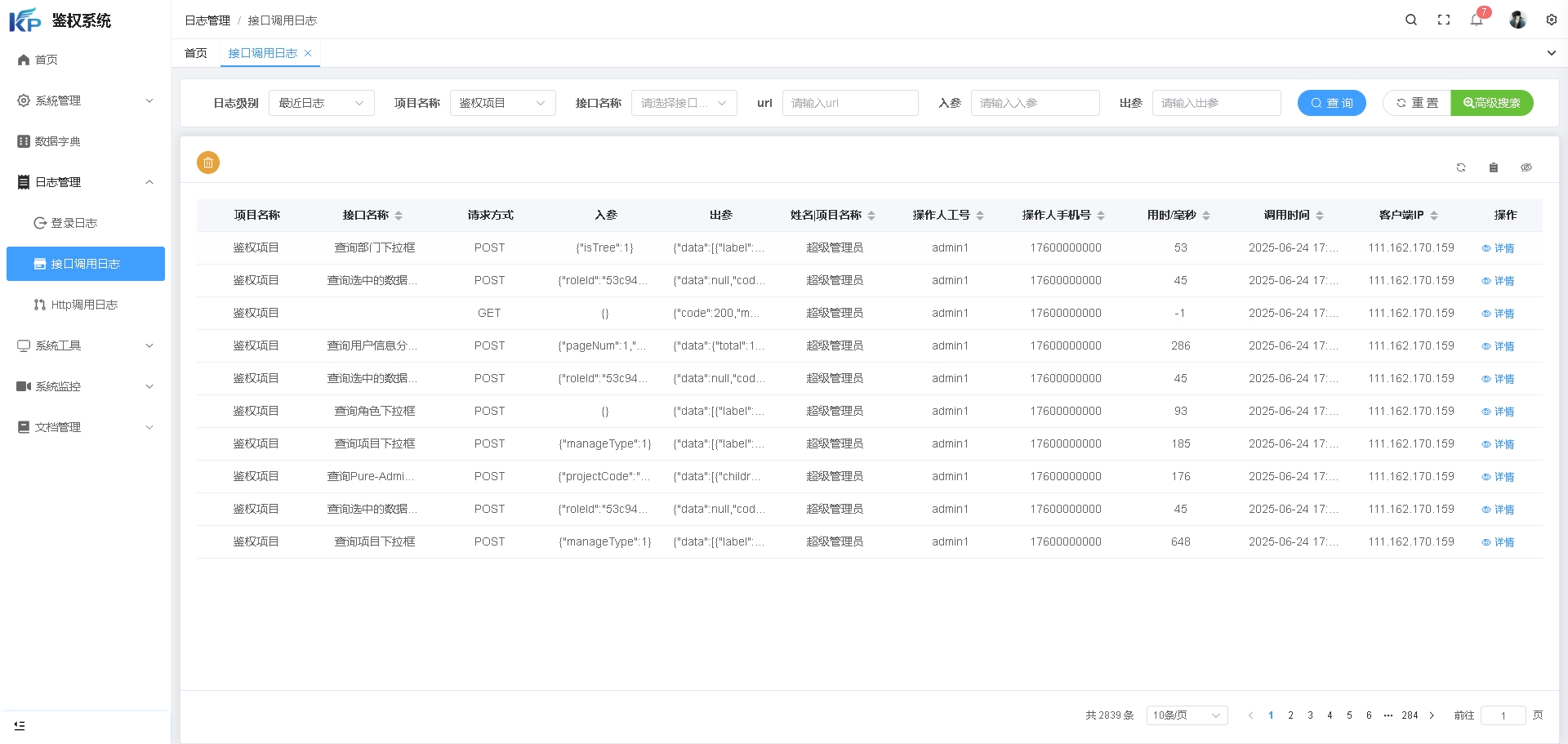
@KPRepeatSubmitNote
作用:防抖注解,用于防止重复提交
说明:添加该注解后可以防止用户(同一个用户)重复提交
参数说明:
value:间隔时间 单位毫秒 默认是800毫秒 表示用户在800毫秒内只能点击一次
用法
@PostMapping("/login") @ApiOperation(value = "普通登录") @KPApiJsonlParam({ @ApiModelProperty(name = "userName", value = "用户账号", required = true, example = "admin1"), @ApiModelProperty(name = "password", value = "密码", required = true, example = "admin1admin1"), @ApiModelProperty(name = "projectCode", value = "项目编号", required = true, example = "authentication"), }) @KPRepeatSubmitNote(1000) # 表示同一用户在1秒内只能点击一次,如果不设置1000 则默认是800毫秒 public KPResult<UserLoginCustomerPO> login(@RequestBody JSONObject parameter) { return KPResult.success(loginService.login(parameter)); }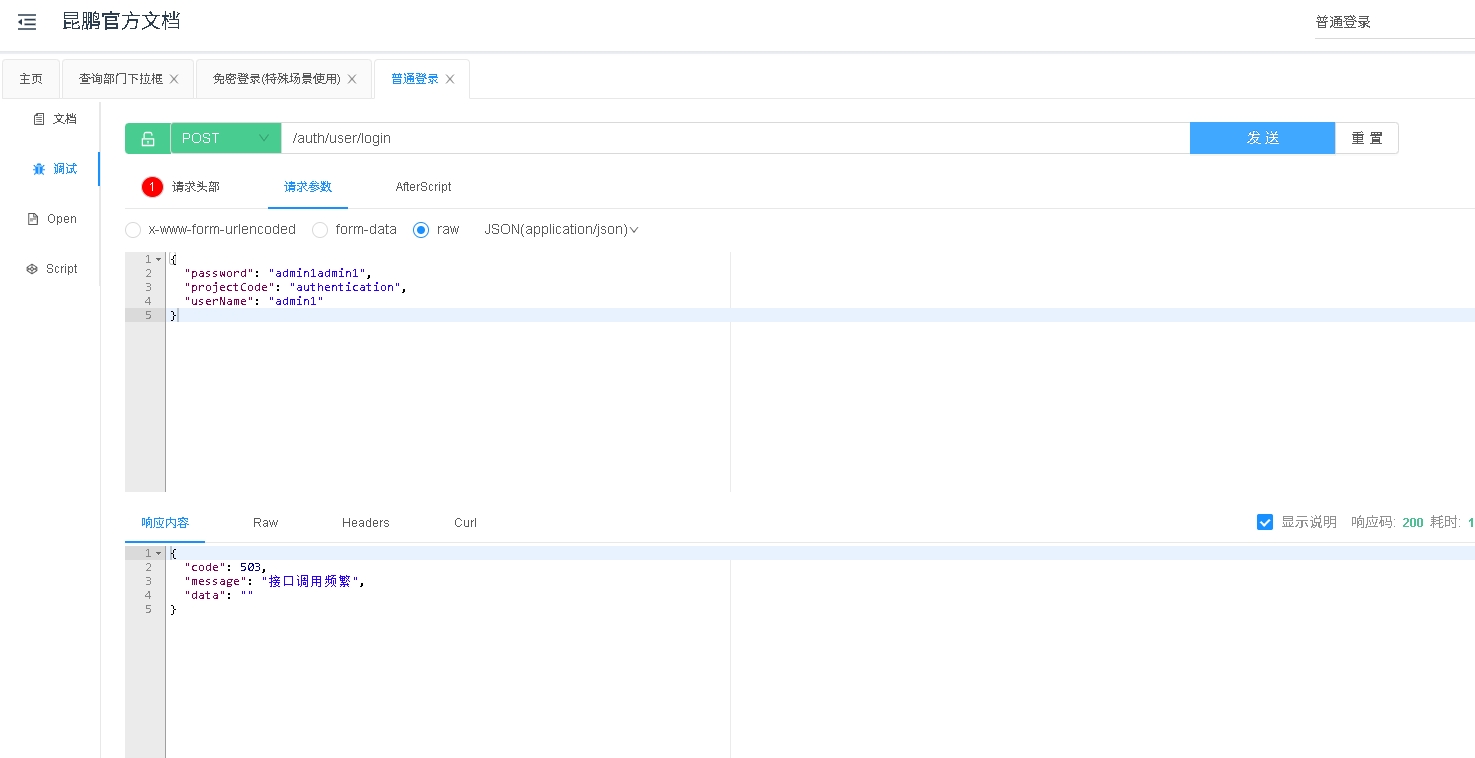
@KPProhibitCrawlerNote
作用:禁止爬虫,用于防止关键接口数据被爬虫抓取
说明:添加该注解后 可以有效保护关键接口数据被爬虫抓取
参数说明:
minute:间隔时间 单位分 默认是5分
minuteCount:接口调用次数 默认50次
forbidHouse:禁止访问时间 单位小时 默认12小时
blacklist:禁止访问次数 默认3次
补充:如果接口添加该注解@KPProhibitCrawlerNote 不设置任何参数 表示 用户5分钟内最多访问该接口50次 如果5分钟超过50次 加入临时黑名单 12小时内禁止访问 同时临时黑名单次数+1。 当用户临时黑名单次数超过3次 则加入永久黑名单 禁止访问。 加入永久黑名单后 相当于该用户永远无法再获取该接口数据
用法
@PreAuthorize("hasPermission('/auth/user/page/list', 'auth:user:page:list')") @ApiOperation(value = "查询用户信息分页列表", notes = "权限 auth:user:page:list") @PostMapping("/page/list") @KPVerifyNote @KPProhibitCrawlerNote(minute = 10, minuteCount = 70) public KPResult<UserListCustomerPO> queryPageList(@RequestBody UserListParamPO userListParamPO){ return KPResult.list(userService.queryPageList(userListParamPO)); }
@KPObjectChangeLogNote
作用:数据库表字段修改记录
说明:添加该注解后 可以记录指定表里面所有字段变更记录 无需开发人员手动记录变化、 例如用户记录 用户名 从 admin 变为 adm,性别男 变为 女
参数说明:
parentMapper:查询数据库所调用的mapper类
identification:唯一标识(数据库主键),查询数据库的条件, 如果数据库字段和实体表字段名称不一样 写 字段名称|数据库字段名称 如 houseId,house_id 英文逗号
operateType:操作类型 填充ObjectChangeLogOperateType 如 ObjectChangeLogOperateType.ADD
businessType:业务类型, 使用者自己扩展
saveDS:保存日志的数据源 默认 kunpeng_auth
saveTableName:保存日志的数据库表名 默认 auth_object_change_log
notRecordField:不记录的改变字段 默认 createDate,updateDate,deleteFlag
补充:添加注解后 会自动记录指定数据表中字段改变内容、开发人员无需开发、只想要前端展示一个变化轨迹页面即可
用法
@PreAuthorize("hasPermission('/auth/role/save','auth:role:save')") @ApiOperation(value = "新增角色信息", notes = "权限 auth:role:save") @PostMapping("/save") @KPVerifyNote @KPObjectChangeLogNote(parentMapper = RoleMapper.class, identification = "roleId,role_id", operateType = ObjectChangeLogOperateType.ADD, businessType="角色") @KPApiJsonlParamMode(component = RoleEditParamPO.class, ignores = "roleId") public KPResult<RolePO> save(@RequestBody RoleEditParamPO roleEditParamPO) { roleService.saveRole(roleEditParamPO); return KPResult.success(); } @PreAuthorize("hasPermission('/auth/role/update','auth:role:update')") @ApiOperation(value = "修改角色信息", notes = "权限 auth:role:update") @PostMapping("/update") @KPObjectChangeLogNote(parentMapper = RoleMapper.class, identification = "roleId,role_id", operateType = ObjectChangeLogOperateType.UPDATE, businessType="角色") @KPVerifyNote public KPResult<RolePO> update(@RequestBody RoleEditParamPO roleEditParamPO) { roleService.updateRole(roleEditParamPO); return KPResult.success(); }
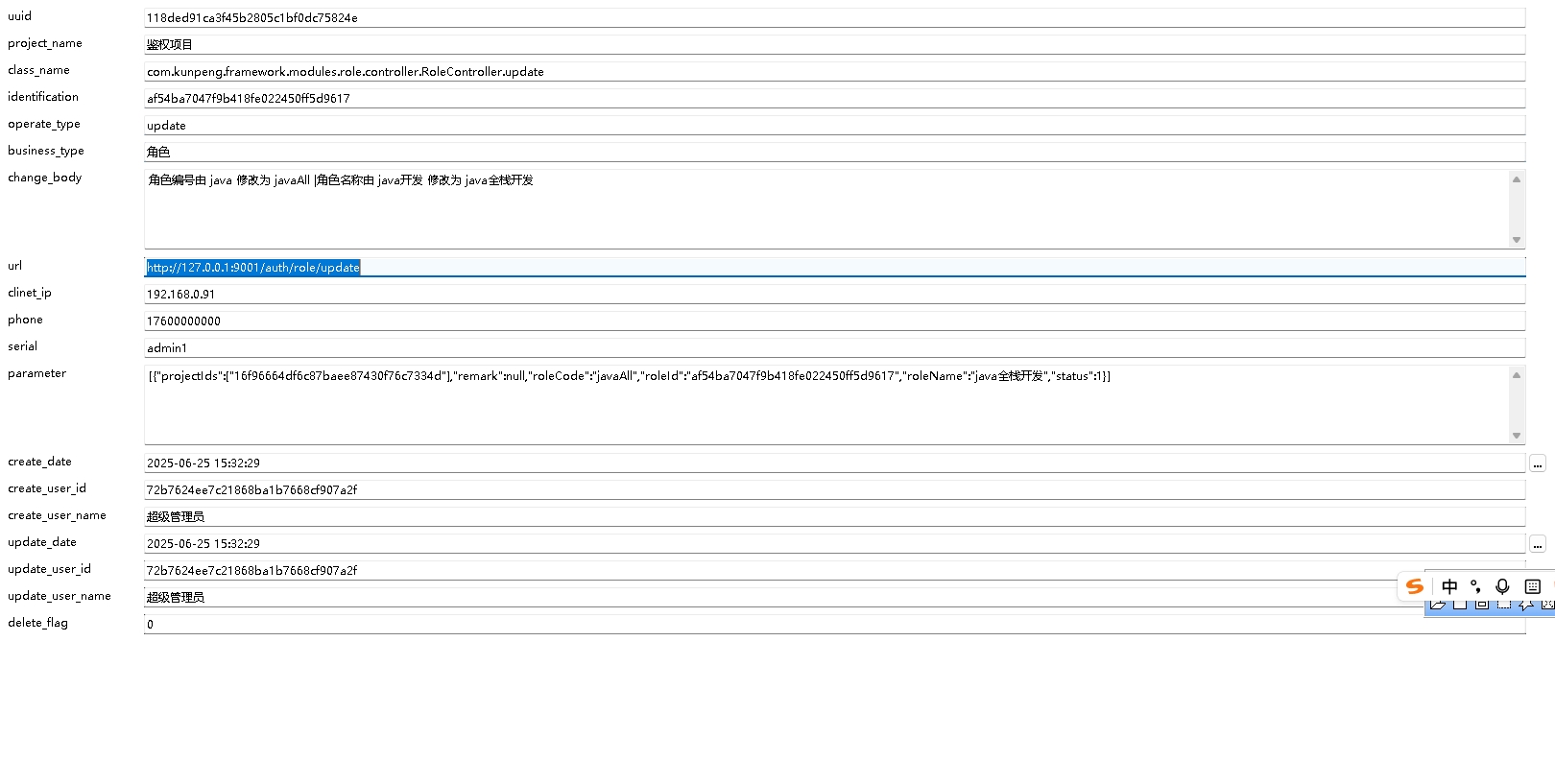
@KPObjectChangeLogListNote
作用:多张数据库表修改记录 @KPObjectChangeLogNote注解的集合
说明:如果一个接口里面要记录多张表的修改记录,可以使用该注解
用法
示例一
@PreAuthorize("hasPermission('/auth/user/save','auth:user:save')") @ApiOperation(value = "新增用户信息", notes="权限 auth:user:save") @PostMapping("/save") @KPVerifyNote @KPObjectChangeLogListNote({ @KPObjectChangeLogNote(parentMapper = UserMapper.class, identification = "userId,userId", operateType = ObjectChangeLogOperateType.ADD, businessType="用户"), @KPObjectChangeLogNote(parentMapper = UserRoleMapper.class, identification = "aurId,aur_id", operateType = ObjectChangeLogOperateType.ADD, businessType="用户角色") }) @KPApiJsonlParamMode(component = UserEditParamPO.class, ignores = "userId") public KPResult<UserPO> save(@RequestBody UserEditParamPO userEditParamPO){ userService.saveUser(userEditParamPO); return KPResult.success(); }示例二
@PreAuthorize("hasPermission('/auth/user/save','auth:user:save')") @ApiOperation(value = "新增用户信息", notes="权限 auth:user:save") @PostMapping("/save") @KPVerifyNote @KPObjectChangeLogNote(parentMapper = UserMapper.class, identification = "userId,userId", operateType = ObjectChangeLogOperateType.ADD, businessType="用户") @KPObjectChangeLogNote(parentMapper = UserRoleMapper.class, identification = "aurId,aur_id", operateType = ObjectChangeLogOperateType.ADD, businessType="用户角色") @KPApiJsonlParamMode(component = UserEditParamPO.class, ignores = "userId") public KPResult<UserPO> save(@RequestBody UserEditParamPO userEditParamPO){ userService.saveUser(userEditParamPO); return KPResult.success(); }